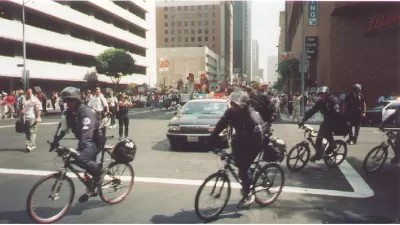Sarah Goodyear offers a brief history of urban development in postwar Europe, and tells of just how close the bicycle capitals of the West came to putting cars before people.
Like all Western cities, Copenhagen and Amsterdam faced tremendous economic and cultural pressure to modernize throughout the 20th century, and to reshape themselves in the image of the automobile. How, then, did these European capitals manage to skirt the trend and emerge as 21st century beacons of hope for human-scale streets?
The key, Goodyear suggests, lies in public protest.
Much of the bicycle- and pedestrian-oriented character seen in the two cities today is not some leftover from a bygone, pre-motorized era, but a recent reclaiming of city space from the automobile. Planners "[ripped] out cycle tracks and [started] to design streets for cars as Europe modernized in the wake of World War II," writes Goodyear. "By the early 1960s, much of the cycling infrastructure that had existed in the pre-war era was gone, and the percentage of the population using bicycles for transportation fell to an all-time low of 10 percent."
It wasn't until the '70s and '80s that the citizens of Copenhagen and Amsterdam came together in protest against rising pedestrian fatalities – many of them children – and the threat of an energy crisis. Danes painted white crosses in the road to mark accident sites where cyclists had been killed. Dutch schools and parents led the charge to bring demonstrators to the streets. The wave of public disapproval steered government planning in a more human-conscious direction.
"What happened was that urban planners started thinking bicycles first and cars second," writes Colville-Andersen. "Building infrastructure to keep cyclists safe and save lives. We haven't looked back since."
FULL STORY: Why the Streets of Copenhagen and Amsterdam Look So Different From Ours

Maui's Vacation Rental Debate Turns Ugly
Verbal attacks, misinformation campaigns and fistfights plague a high-stakes debate to convert thousands of vacation rentals into long-term housing.

Planetizen Federal Action Tracker
A weekly monitor of how Trump’s orders and actions are impacting planners and planning in America.

San Francisco Suspends Traffic Calming Amidst Record Deaths
Citing “a challenging fiscal landscape,” the city will cease the program on the heels of 42 traffic deaths, including 24 pedestrians.

Defunct Pittsburgh Power Plant to Become Residential Tower
A decommissioned steam heat plant will be redeveloped into almost 100 affordable housing units.

Trump Prompts Restructuring of Transportation Research Board in “Unprecedented Overreach”
The TRB has eliminated more than half of its committees including those focused on climate, equity, and cities.

Amtrak Rolls Out New Orleans to Alabama “Mardi Gras” Train
The new service will operate morning and evening departures between Mobile and New Orleans.
Urban Design for Planners 1: Software Tools
This six-course series explores essential urban design concepts using open source software and equips planners with the tools they need to participate fully in the urban design process.
Planning for Universal Design
Learn the tools for implementing Universal Design in planning regulations.
Heyer Gruel & Associates PA
JM Goldson LLC
Custer County Colorado
City of Camden Redevelopment Agency
City of Astoria
Transportation Research & Education Center (TREC) at Portland State University
Jefferson Parish Government
Camden Redevelopment Agency
City of Claremont





























